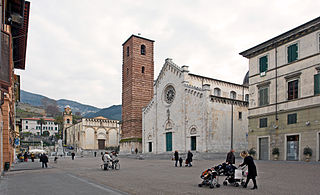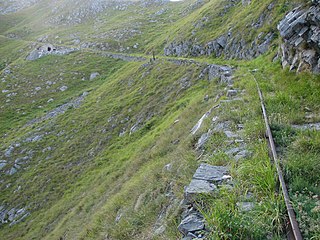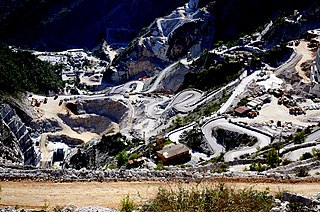
Piacenza is a city and comune in the Emilia-Romagna region of northern Italy, the capital of the eponymous province. The etymology is long-standing, tracing an origin from the Latin verb placēre, "to please." In French, and occasionally in English, it is called Plaisance. The name means a "pleasant abode", or as James Boswell reported some of the etymologists of his time to have translated it, "comely". This was a name "of good omen."

Cividale del Friuli is a town and comune in the Province of Udine, part of the North-Italian Friuli Venezia Giulia regione. The town lies 135 metres (443 ft) above sea-level in the foothills of the eastern Alps, 15 kilometres (9 mi) by rail from the city of Udine and close to the Slovenian border. It is situated on the river Natisone, which forms a picturesque ravine here. Formerly an important regional power, it is today a quiet, small town that attracts tourists thanks to its medieval center.

Carrara is a city and comune in Tuscany, in central Italy, of the province of Massa and Carrara, and notable for the white or blue-grey marble quarried there. It is on the Carrione River, some 100 kilometres (62 mi) west-northwest of Florence. Its motto is Fortitudo mea in rota.

Carrara marble, Luna marble to the Romans, is a type of white or blue-grey marble popular for use in sculpture and building decor. It has been quarried since Roman times in the mountains just outside the city of Carrara in the province of Massa and Carrara in the Lunigiana, the northernmost tip of modern-day Tuscany, Italy.

Norcia, traditionally known in English by its Latin name of Nursia, is a town and comune in the province of Perugia (Italy) in southeastern Umbria. Unlike many ancient towns, it is located in a wide plain abutting the Monti Sibillini, a subrange of the Apennines with some of its highest peaks, near the Sordo River, a small stream that eventually flows into the Nera. The town is popularly associated with the Valnerina.

The Lunigiana is a historical territory of Italy, which today falls within the provinces of Massa Carrara, Tuscany, and La Spezia, Liguria. Its borders derive from the ancient Roman settlement, later the medieval diocese of Luni, which no longer exists.

Pietrasanta is a town and comune on the coast of northern Tuscany in Italy, in the province of Lucca. Pietrasanta is part of Versilia, on the last foothills of the Apuan Alps, about 32 kilometres (20 mi) north of Pisa. The town is located 3 kilometres (1.9 mi) off the coast, where the frazione of Marina di Pietrasanta is located.

Palazzolo Acreide is a town and comune in the Province of Syracuse, Sicily. It is 43 kilometres (27 mi) from the city of Syracuse in the Hyblean Mountains.

Lardo is a type of salumi made by curing strips of fatback with rosemary and other herbs and spices.

Massa is a town and comune in Tuscany, central Italy, the administrative centre of the province of Massa and Carrara. It is located in the Frigido River Valley, near the Alpi Apuane, 5 km (3 mi) from the Tyrrhenian Sea.

Castelnuovo di Garfagnana is a town and comune in the province of Lucca, Toscana, central Italy. It is located at the confluence of the Serchio and the Turrite Secca rivers, close to the intersection of roads passing through the Apennine Mountains and the Apuan Alps.

Luni is a comune (municipality) in the province of La Spezia, in the easternmost end of the Liguria region of northern Italy. It was founded by the Romans as Luna. It gives its name to Lunigiana, a region spanning eastern Liguria and northern Tuscany.

Retignano is a village of about 400 inhabitants, located on a hill in the historical Versilia, a northern area of the Italian region of Tuscany, in the municipality of Stazzema, about 430 meters above sea level. The inhabitants are called Retignanesi.

The Lizza di Piastreta, also known as Monorotaia di Piastreta, was an Italian industrial monorail serving the marble quarry of Piastreta, in the Apuan Alps, and linking it to Renara, in the municipal territory of Massa, Tuscany.

The Marmifera, full name Italian: Ferrovia Marmifera Privata di Carrara, lit. 'private marble railway of Carrara', was an Italian industrial railway used for the transport of Carrara marble from the quarries of the municipal territory of Carrara, Tuscany. The route extended from the hillside village of Colonnata to the port of Marina di Carrara.

Rock shelter of the Equi Spa is located on the northern fringe of the Apuan Alps, not far from the famous Carrara marble quarries in northern Italy. The Rock shelter is located by a small the small hamlet of Equi Terme which is a currently developing tourist attraction with three selling points, an archaeological site, a natural cave system and a hiking trail along the northern fringe of the Apuan Alps.

Miseglia is a village in Tuscany, central Italy, administratively a frazione of the comune of Carrara, province of Massa-Carrara. At the time of the 2011 census its population amounted to 449.

Montalto is a mountain located in Tuscany, Italy and part of the Apuan Alps range. Its highest peak is at roughly 913 meters above the sea level and it is also home of two villages, Retignano and Volegno, in the municipality of Stazzema, Province of Lucca.

Castelpoggio is a frazione (borough) of the comune of Carrara, in northwest Tuscany, central Italy. As of 2001, it had around 360 inhabitants.
No Cav is a journalistic term used to indicate a large Italian protest movement that arose in the early years of the 21st century composed of associations and groups of citizens united by the criticism of the Carrara marble quarries in the Apuan Alps.





















